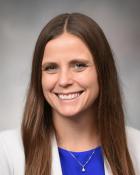Anomalous pulmonary venous return is a type of heart defect that affects the veins going from the lungs to the heart. Most children who have surgery to treat this rare condition go on to live long and healthy lives. However, they will still need regular follow-up care. The specialists at the Adult Congenital Heart Program at UK Gill Heart & Vascular Institute have the expertise you need to treat all types of anomalous pulmonary venous return.
In a healthy heart, four pulmonary veins carry oxygen-rich blood from the lungs to the left upper chamber of the heart (left atrium). The left side of the heart is responsible for sending that blood out to the rest of the body, ensuring every organ gets plenty of oxygen. When there is anomalous pulmonary venous return, the blood vessels instead connect to the right atrium. As a result, the blood flows back to the lungs instead of out to the body, which means the body doesn’t get the oxygen it needs.
Two main types of anomalous pulmonary venous return occur:
- Total anomalous pulmonary venous return (TAPVR), also called total anomalous pulmonary venous connection, affects all the pulmonary veins.
- Partial anomalous pulmonary venous return or connection (PAPVR) affects only some of the veins and is usually a less serious condition.
Anomalous pulmonary venous return is usually diagnosed in infancy, but milder cases can remain undiagnosed until childhood. Infants with the condition may have symptoms such as:
- Blue skin or nails
- Inability to grow properly
- Lack of energy
- Poor eating
- Rapid breathing
- Respiratory infections
- Trouble breathing
- Weak pulse
Sometimes, the condition is diagnosed after a pediatrician hears a heart murmur.
In rare cases, patients with TAPVR or PAPVR may reach adulthood before diagnosis. When this happens, symptoms usually include:
- Inability to withstand exercise
- Shortness of breath
- Adults with undiagnosed PAPVR may also have symptoms such as:
- Fatigue
- Pulmonary hypertension
- Recurrent pneumonia
Occasionally, adults with TAPVR who had successful surgery as children will develop an abnormal heart rhythm or arrhythmia.
Most children who have successful surgeries to treat TAPVR or PAPVR go on to lead healthy lives as adults. It is rare for adults to develop complications from surgery after so many decades, but obstruction in the pulmonary veins can sometimes develop and could require cardiac catheterization or additional surgery. Overall, the prognosis for the majority of patients is excellent, as long as they keep up with follow-up care.
There are no known causes for anomalous pulmonary venous return. However, the birth defects may be connected to an as-yet-unidentified chromosomal problem, especially when combined with environmental risk factors. Research is on going as to which specific risk factors could ultimately lead to TAPVR or PAPVR.
Children with congenital heart disease become adults with congenital heart disease (CHD). Ninety percent of children born with CHD have a normal life expectancy due to improved surgical interventions and better medical management. At all ages, close monitoring and expert care for CHD patients are essential. Despite this, studies indicate that 2 out of 3 young adults with CHD don’t transition from pediatric to adult CHD care. Not getting continued cardiac care can lead to a variety of health problems and poor outcomes.
To guide teens and their families through the transition, UK Gill Heart & Vascular Institute team members talk about the transition early and often. Starting at age 15, teens with CHD begin transition education. One Wednesday every month, a special transition clinic staffed by adult congenital heart disease providers, is held to meet with teens and their families to discuss important topics, including:
- Abilities and limitations experienced as an adult with CHD
- Lifelong need for proper CHD monitoring and treatment
- What adult CHD care may involve over the years
Additionally, once you transition to adult care with the Adult Congenital Heart Program at UK Gill Heart & Vascular Institute, we work hard to enable you to keep your appointments and testing on track. We also work hard to empower you with knowledge and assist you in being your best advocate to live your best life. If you miss an appointment, we will call to reschedule.
During your first visit to the UK Gill Heart & Vascular Institute’s Adult Congenital Heart Program, you’ll meet our clinic nurse, social worker and other members of your care team. You’ll also undergo imaging exams, which may include an echocardiogram or a cardiac MRI.
Once imaging is complete, you will meet with an adult congenital cardiologist and other team members for up to one hour. You’ll discuss the results of your echocardiogram and your health history and symptoms. You will also get in-depth education about your diagnosis, how it may affect you moving forward and possible treatment options. The meeting is also a great opportunity to ask any questions about living with CHD.
When coming to your appointment:
- Bring a list of any medications or supplements you take and surgeries you’ve undergone.
- Dress comfortably.
- Have your insurance information on hand. UK HealthCare accepts most insurers, and financial assistance is available.
- You may want a family member or friend with you to take notes or help ask questions.
Where we are located
The UK Gill Heart & Vascular Institute is located at 800 Rose St. in Pavilion G, on the first floor of UK Albert B. Chandler Hospital. We will mail you a map and directions when your appointment is scheduled.
Patient drop-off
Patients can be dropped off in front of the main entrance to Albert B. Chandler Hospital at 1000 S. Limestone. If you are dropped off at the main entrance, you’ll enter the revolving doors on the ground floor of the hospital. Take the main stairs just to the left (or elevator across the atrium) to the first floor of Pavilion A.
After climbing the stairs or taking the elevator, turn left. You’ll pass the Kentucky Wall and Kentucky Children’s Hospital on your right. Continue to the end of the hall until it comes to a T shape. Turn left and the Gill clinic entrance is across from an open area housing the organ donor wall.
Parking
It is easiest to park in the UK HealthCare Parking Garage, across from the hospital at 110 Transcript Ave.
There are two paths from this garage to the Gill clinic:
- You may take the free shuttle from Level A of the parking garage. You’ll exit the shuttle at the Pavilion A/ Pavilion G stop in front of the main entrance to the hospital. After climbing the stairs or taking the elevator, turn left. You’ll pass the Kentucky Wall and Kentucky Children’s Hospital on your right. Continue to the end of the hall until it comes to a T shape. Turn left and the Gill clinic entrance is across from an open area housing the organ donor wall.
- From Level C of the parking garage you may walk or take a golf cart across the pedway to the first floor of Pavilion A. Turn left past the help desk and walk away from the dining hall. You’ll pass the Kentucky Wall and Kentucky Children’s Hospital on your right. Continue to the end of the hall until it comes to a T shape. Turn left and the Gill clinic entrance is across from an open area housing the organ donor wall.
If you need help finding your way, information desks are located inside the main entrances to Pavilion A, both on the ground floor and at the end of the pedway on the first floor. You may also call the information desk at 859-323-5816.
Clinical trials provide access to novel treatments for those in the adult CHD program at UK Gill Heart & Vascular Institute. Through our Cardiology Clinical Research Center, patients benefit from advances in valve replacement and other therapies before they become standard treatment. Your care team will notify you if you qualify for an ongoing clinical trial.








